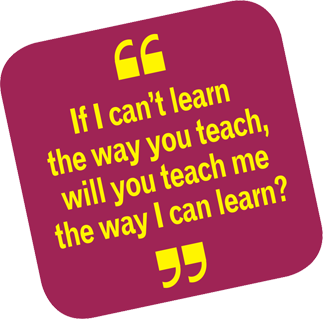Welcome and thank you for coming to our website. As a parent, probably of a child with Dyslexia, you will have concerns and questions and we hope to answer them quickly and effectively in this section.
We have tried to answer the questions that we know are uppermost in most parents’ minds, but if we haven’t covered your specific question, please feel free to email us at mda@dyslexiaindia.com
- What is Dyslexia?
- How do I know if my child has Dyslexia?
- How do I get help from my child’s school?
- What is involved in an assessment for Dyslexia?
- As a parent, how do I help my child?
- What legal rights/provisions does my child have?
- How do I get private Dyslexia tuition for my child?
- How do I meet other parents in the same situation?
- What publications would you recommend that I read?
- What can MDA do for me
What is Dyslexia?
Dyslexia literally means "difficulty with words” (from the Greek “dys” meaning problem and “lexis” meaning words or language). It is a specific learning difficulty which affects a person's ability to read, spell and understand language that he/she hears, or express himself/herself clearly while speaking or in writing.
Dyslexia is not a disease; it has no cure. Dyslexia is caused by irregularities in the way information is processed in a brain which is often gifted and productive in many other areas. Dyslexia is not the result of low intelligence. People with Dyslexia are unique, each having individual strengths and weaknesses. Many individuals with Dyslexia are creative and have unusual talents in areas such as art/graphics, sport, architecture, electronics/computing, drama, music, or mechanics/engineering. They often display special talents in areas that require good visual, spatial, and motor integration. Their problems in processing language and information distinguish them as a group. This means that a person with Dyslexia may have problems translating language to thought (as in listening or reading) or thought to language (as in writing or speaking).
Formal Definition of Dyslexia
Dyslexia is a specific learning disability that is neurological in origin.
It is characterized by difficulties with accurate and/or fluent word recognition and by poor spelling and decoding abilities.
These difficulties typically result from a deficit in the phonological component of language that is often unexpected in relation to other cognitive abilities and the provision of effective classroom instruction.
Secondary consequences may include problems in reading comprehension and reduced reading experience that can impede growth of vocabulary and background knowledge.
- Adopted by the Board of the International Dyslexia Association in November 2002; also used by the National Institute of Child Health and Human Development, USA.
Definition of Specific Learning Disability in the Rights of Persons with Disabilities Bill, 2012, Government of India, Ministry of Social Justice & Empowerment, Department of Disability Affairs, September, 2012:
'Specific Learning Disability' refer to a heterogeneous group of conditions wherein there is a deficit in processing language, spoken or written, that may manifest itself as a difficulty to comprehend, speak, read, write, spell, or to do mathematical calculations. The term includes such conditions as perceptual disabilities, Dyslexia, Dysgraphia, Dyscalculia, Dyspraxia and Developmental Aphasia.
How do I know if my child has Dyslexia?
We outline below some of the common indications of Dyslexia. It is important to understand that development varies from child to child, and every child will probably display a few of these difficulties. Any child displaying a cluster of these indicators should be assessed by a competent professional.
Preschool
- Speaks later than most children
- Pronunciation problems
- Difficulty rhyming words
- Slow vocabulary growth, often unable to find the right word
- Trouble learning the alphabet, numbers, days of the week, colours, shapes
- Extremely restless and easily distracted
- Trouble interacting with peers
- Difficulty following directions
- Slow to develop fine motor skills
Pre-Primary - Primary
- Slow to learn the connection between letters and sounds
- Confuses between basic words (hot/cold, up/down)
- Makes consistent reading and spelling errors including letter reversals (b/d, p/q) and inversions u/n, m/w; transpositions/inversions (felt/left, from/form) and substitutions (house/home)
- Transposes number sequences and confuses computation signs (+, -, x, /, =)
- Slow to remember facts
- Slow to learn new skills, relies heavily on memorisation
- Impulsive, difficulty with planning
- Trouble learning about time
- Unstable pencil grip
- Poor co-ordination, unaware of physical surroundings, prone to accidents
Middle School
- Frequently reverses the sequence of letters and/or words (was/saw, tops/spot, ‘You are how?’ for ‘How are you?’)
- Slow to learn prefixes, suffixes, root words, and other spelling strategies
- Avoids reading aloud
- Trouble with word problems
- Difficulty with handwriting
- Awkward, fist-like, or tight pencil grip
- Avoids writing compositions
- Slow or poor recall of facts
- Difficulty making friends
- Trouble understanding body language and facial expressions
High School
- Continues to spell incorrectly, frequently spells the same word differently in a single piece of writing.
- Avoids reading and writing tasks.
- Trouble summarising.
- Trouble with open-ended questions on tests.
- Weak memory skills.
- Difficulty adjusting to new settings.
- Works slowly.
- Poor grasp of abstract concepts.
- Either pays too little attention to details or focuses on them too much.
- Misreads information.
General Warning Signs
- Short attention span / unable to concentrate: not able to pay attention long enough to finish an activity.
- Restless or hyperactive: moves around constantly; fidgety; doesn't seem to move with a purpose in mind; picks on other children.
- Does not complete tasks; careless, unorganized approach to activities: does not finish what is started; does not seem to plan to get work done.
- Listening difficulties; does not seem to understand: has trouble following directions; turns away while others are talking; does not seem interested.
- Avoids participation with other children or only knows how to play by hurting others: stays away from other children; always plays alone; does not participate in group activities; bites, hits, or bullies.
- Resistant to discipline or direction (impertinent, defiant, resentful, destructive, or negative): does not accept directions or training; disagreeable; hard to manage; destroys materials or toys deliberately; temper tantrums.
- Speech problems:
- Unusually fast or slow speech.
- Articulation: difficulty making clear speech sounds.
- Stuttering: difficulty with flow of speech; repeating sounds, words, or phrases; blocking words or sounds.
- Voice: unusually loud, soft, high or low; scratchy or hoarse quality.
- Physical complaints: talks of being sick or hurt; seems tired or without energy.
- Temperamental, overly sensitive, sad, irritable: moody, easily depressed, unhappy, shows extreme emotions and feelings.
How do I get help from my child’s school?
It is important to discuss your concerns with your child’s class teacher. By talking to him/her, you will achieve two things: first, you will alert the teacher to a possible problem and second, you will start the process of getting your child the necessary understanding, professional evaluation and support. Feedback from the classroom teacher is important for an in-depth assessment of your child’s learning profile and the nature of his or her difficulties. You should also meet the School Counsellor, Supervisor or Principal for a referral to a recognised Professional or Clinic for further guidance and assessment.
What is involved in an assessment for Dyslexia?
A formal assessment is useful for a number of reasons:
- to assess how to improve key skills
- to communicate your child’s problems to others, including teachers and school administrators
- to secure time allowances in exams and other provisions laid out by the local education boards.
A comprehensive assessment that examines a wide range of different factors which could be making it difficult for your child to learn is important. It is carried out by a psychologist, reading specialist or a special educator specially trained in these diagnostic assessments. It is designed to identify Dyslexia and/or other recognised patterns of specific learning difficulties.
What is assessed?
- Developmental History
- Medical History
- Educational History
- Family History
- Psycho-social History
- Cognitive or Intellectual Ability
- Achievement
On completion of assessment, the assessor will produce a written report which includes recommendations on what action needs to be taken.
Dyslexia, like other Specific Learning Difficulties, encompasses a broad range of intellectual abilities and is identified by a characteristic profile of strengths and weaknesses. This profile pattern will be the key for you as parents and for your child’s teachers to determine the level of support required.
A list of appropriate Diagnostic Tests for Specific Learning Disability is available in the Assessments section on the website.
How do I help my child?
It is important for a child with Dyslexia to be taught to read and write by professional teachers using a method that involves several senses (hearing, seeing, touching) at the same time. Many children with Dyslexia need one-on-one help so that they can move forward at their own pace. For students with Dyslexia, it is helpful if their non-classroom academic therapists work closely with classroom teachers.
As a parent, you need to push for your child to have one-on-one help as soon as possible and as often as possible. The ideal commitment is three sessions of one hour per week. Getting the school to provide a therapist and a classroom is ideal, but this may not always be possible.
Some ideas to help a child with Dyslexia (adapted from Source and Copyright: Dyslexia Contact. Volume 5, No. 1, May 1986)
- Be encouraging of your child’s strengths.
- Be patient and persevering with your child’s teacher. Make yourself known to all new teachers.
- Be patient and persevering with your child - patiently teach him/her to do things for himself/herself; to tie his/her tie (do this over his shoulder in front of the mirror), tie his/her shoe laces, to dress correctly, to tell the time, left from right, etc. Be patient also with the progress being made once teaching help is being given - miracles don’t happen; it takes time, determination and hard work.
- Teach your child independence. For example, send him/her on simple errands, encourage the use of the telephone, particularly the public phone. Organise for your child to make a bus journey alone, giving instructions of what time the bus comes and how many stops to count before getting off.
- Be aware of the problems, symptoms and signs of stress. Your child may be experiencing a great deal of frustration in many areas of their life. Be aware of stress signs, such as bed-wetting and introversion which need subtle handling. Aggression and anti-social behaviour have to be checked gently, but firmly. Never think all the stress signs are because of Dyslexia – they are growing up too and will go through the normal problems of adolescence. It is a good idea to talk to parents of children who do not have Dyslexia - how are they behaving? It helps to get things into perspective.
- Be aware of the ignorance and misunderstanding you will meet at all levels. Head teachers, teachers, G.Ps, psychologists, employers, etc., often do not understand nor do they have any sympathy for the person with Dyslexia.
- Avoid too much pressure at home. Are you aware that your child has to work exceedingly hard at school and gets very, very tired? Your child may even become so exhausted that he/she may need a day off occasionally. So avoid pressure at home with reading and writing. Even though they may forget a lot during school holidays, let them have holidays.
- Try and alleviate jealousies between siblings. Your child with Dyslexia is very dependent on you and you probably give him/her a great deal of your attention. It is natural that other children in the family who appear to be doing well without any help from you may feel left out or jealous. Never fall into the trap of comparing one child to another either in or out of your family.
- Try and avoid stress at home in case your child faces a situation of failure; they get enough of that at school. Also avoid showing your anxiety as it adds to feelings of inadequacy.
- Read to your child, never mind the age.
- Watch TV with your child and discuss what you see.
- Play games with your child. Games involving the whole family or even just the both of you will help to build a bond between you and your child.
- Keep your child’s motivation high; build on strengths and offer encouragement. Encourage leisure activities such as sports, collecting stamps, modelling, cooking, etc.
- Give praise; take no achievement for granted: a slight improvement in handwriting, laying the table correctly, etc.
- Boost your child’s self-confidence and self-esteem. Even if he/she appears self-assured, deep down he/she may still be very anxious.
- Offer practical help with buttons and laces. Three of the most difficult tasks for a parent to teach their children are: fastening shoes, fastening buttons and tying ties. First, you must realise that a left-handed person performs these tasks differently from a right-handed person. So, if you are right-handed and your child is left-handed (or vice versa) you should always FACE your child when showing him/her how to tie his/her tie or shoe laces. BUT if you both are right-handed or left-handed, you must stand BEHIND him/her. Secondly, do encourage your child to put into words what he/she is doing. For teaching children how to tie shoe laces, try using a piece of white cord, half of which is dyed red (or two different coloured boot laces fastened together), and place the red on the right. Using a man's shoe, place the toe of the shoe away from the child. This combination makes it easier for the child to distinguish the different ends and bows, etc. One idea is to buy grown-up laces for your child's shoes. This gives him/her the extra length to play with. Some children find it easier after tying the initial half hitch to make two loops and then tie together to play with. Experiment!! A tip for fastening buttons on coats or cardigans, shirts and blouses (and this applies to adults as well!!) ALWAYS start at the BOTTOM, where you can see what you are doing - not at the top under your chin, or half-way down where it is guesswork.
What legal rights does my child have?
Once your child has a diagnosis of Dyslexia from a competent professional, he or she is entitled to curricular and examination provisions that are mandated by the Board that the school is affiliated to, and by the education department of the state you reside in.
Detailed information about these provisions can be found in the Exam Provisions section on our website.




